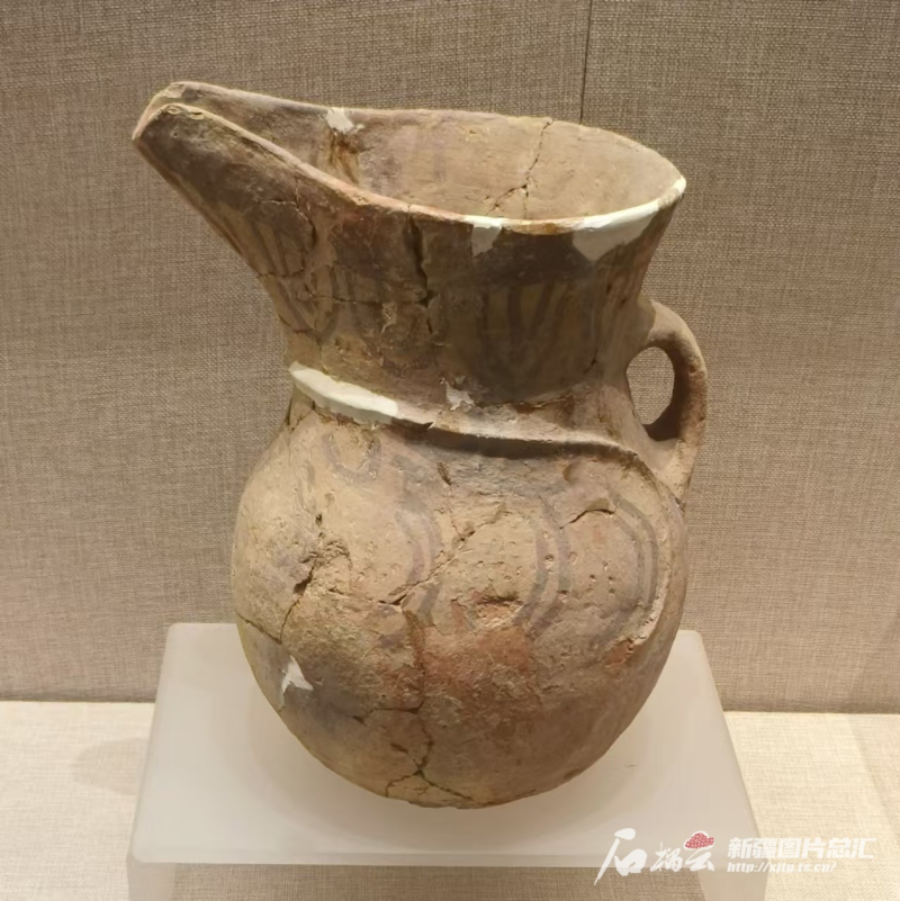Shiliuyun-Xinjiang Daily (Reporter Wang Xinhong) news: Today, water containers are quite common, such as water buckets, basins, and jars. But what did water containers look like more than 3,000 years ago? There is a large painted pottery jar with a single handle and a spout at the Aksu Museum in Aksu Prefecture, northwest China's Xinjiang Uygur Autonomous Region. According to experts, this jar is a water container from over 3,000 years ago and is currently the largest piece of pottery with a spout found in Xinjiang.

Photo shows a large painted pottery jar with a single handle and a spout housed at the Aksu Museum in Aksu Prefecture, northwest China's Xinjiang Uygur Autonomous Region. (Photo by Shiliuyun-Xinjiang Daily/Wang Xinhong)
This pottery jar, dating back to the Western Zhou period, is a national first-class cultural relic. It was unearthed in 1999 at the Duogang cemetery in Baicheng County, Aksu Prefecture. Standing at 45.9 centimeters in height and with a mouth diameter of 29.9 centimeters, the jar features a wide and upturned spout, a single handle on the shoulder, ochre triangular patterns on the neck, and irregular zigzag patterns on the abdomen. It is decorated with a ring-shaped handle on one side, facilitating the pouring spout. "The name of this jar is also derived from its exterior painted designs," said Yang Hong, a docent at the Aksu Museum.
Pottery was an indispensable item in the daily lives of ancient people. Records indicate that as early as the Bronze Age and the early Iron Age, China's painted pottery had already demonstrated a rich cultural diversity and distinct regional styles. Among them, the Central Plains, Gansu and Qinghai were the most developed.
Experts have determined that the painted pottery found in Xinjiang bears similarities to that discovered in Gansu and Qinghai in terms of form, design, and production methods. Xinjiang's painted pottery also exhibits unique traits, with the most prominent being the abundance of triangular motifs. This is a creative expression of how ancient residents in Xinjiang incorporated their own artistic elements into the pottery after being influenced by the painted pottery from the east. This indicates a close cultural exchange and connection between the Xinjiang and the Central Plains.
Yang introduced that the pottery unearthed in Aksu spans from the Western Zhou period to the Tang Dynasty, with the most exquisite pieces found in the Kizil reservoir cemetery and Duogang cemetery in Baicheng County, Bozidun ancient tombs in Wensu County, and Qiuci Wei and Jin Dynasty ancient tombs in Kuqa City. The early pottery is often decorated with ochre red patterns, mainly featuring checkerboard patterns, diamond patterns, and triangular patterns, reflecting the aesthetic tastes of the ancient residents of Aksu. From the decorative techniques and pattern styles, these painted potteries are clearly influenced by the painted pottery culture of Gansu.
(A written permission shall be obtained for reprinting, excerpting, copying and mirroring of the contents published on this website. Unauthorized aforementioned act shall be deemed an infringement, of which the actor shall be held accountable under the law.)









